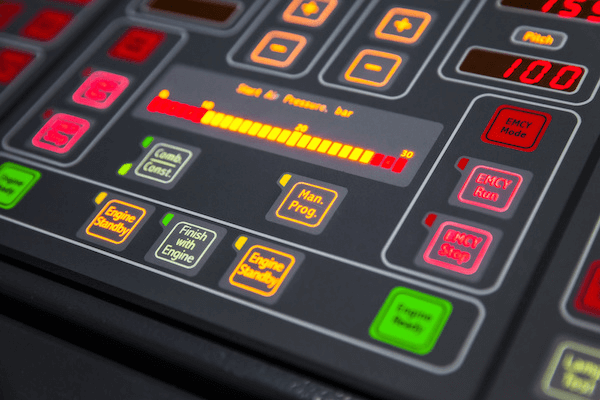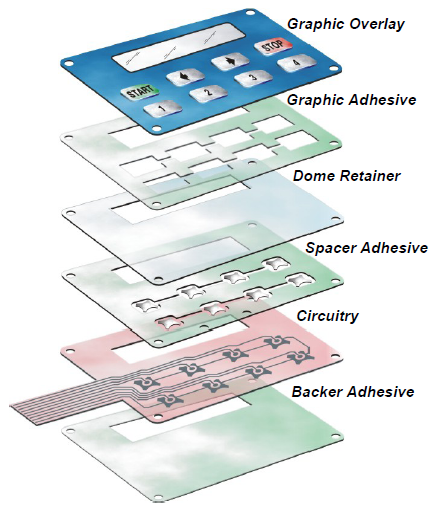The Manufacturing Process Behind Membrane Change: What You Required to Know
The production process behind membrane layer switches combines mindful layout, material choice, and high quality control. It starts with comprehending the details of membrane layer switch design and proceeds through different stages, consisting of material options and printing strategies. Each stage plays a crucial role in making sure performance and durability. The complexities of layer building and construction and the rigorous testing criteria might disclose insights that are not instantly noticeable. What exists beyond these foundational aspects?
Recognizing Membrane Layer Change Layout
Although membrane buttons might appear simple initially glimpse, their design includes detailed factors to consider that guarantee capability and sturdiness. The style process starts with an extensive understanding of user needs, consisting of the interface's intended application and ecological aspects. Ergonomics is a crucial element, as the layout should help with simplicity of usage while ensuring that tactile comments satisfies user expectations.Moreover, the layering of elements, such as graphic overlays, glue layers, and conductive traces, must be exactly engineered. membrane switch. This layered arrangement not only affects the button's responsiveness but also affects its long life. Interest is offered to the sealing techniques used to safeguard versus dampness and dirt, which could endanger efficiency. Furthermore, style factors to consider include visual appeals, where shade schemes and aesthetic clearness enhance individual experience. Ultimately, the layout of membrane changes equilibriums functionality, individual experience, and sturdiness, making certain that they satisfy the demands of numerous applications efficiently
Materials Used in Membrane Switch Manufacturing
When choosing products for membrane switch production, it is important to contemplate both efficiency and longevity. The primary materials include polyester and polycarbonate movies, which supply adaptability and toughness. These movies are usually coated with adhesive to assure proper bonding to substrates. Conductive inks, usually composed of silver or carbon, are important for creating electrical links within the button, enabling for reliable operation.Additionally, a protective layer, such as a hard coat, is frequently put on enhance scratch resistance and durability. The choice of backing product, such as acrylic or foam, can significantly impact the button's responsive feel and general customer experience. Moreover, numerous ecological variables, including temperature level and humidity, should assist material selection to guarantee peak efficiency in specific applications. Ultimately, the ideal combination of materials contributes to the membrane switch's performance and life-span, making informed choices essential for suppliers.
The Printing Refine: Creating Video and Text
The printing procedure in membrane layer button production plays a substantial role in producing top notch graphics and text. Various graphic layout strategies are used to ensure aesthetic appeal and performance, while careful ink selection methods are important for sturdiness and performance. Comprehending these components is fundamental for attaining best lead to membrane switch design.
Graphic Layout Techniques
Graphic style techniques play a crucial role in the printing process of membrane switches, as they define how graphics and text will eventually appear on the end product. Efficient graphic design entails the strategic use fonts, shades, and formats to improve readability and visual appeal. Designers typically make use of vector graphics for scalability, guaranteeing that photos remain sharp at numerous sizes. Furthermore, interest to contrast and placement is essential, as it influences user interaction and visual quality. The unification of branding elements, such as logo designs, need to be handled with treatment to maintain brand name integrity. Overall, thoughtful graphic style techniques contribute substantially to the performance and attractiveness of membrane layer buttons, influencing individual experience and product efficiency.
Ink Choice Approaches
Selecting the proper ink is necessary for attaining the preferred aesthetic quality and resilience in membrane layer button manufacturing. Various ink types are used, including solvent-based, water-based, and UV-curable inks. Each type supplies unique qualities, such as adhesion, adaptability, and resistance to ecological elements. Solvent-based inks are commonly favored for their longevity and vibrant shades, while water-based inks are more eco friendly yet might have restrictions in attachment. UV-curable inks supply fast treating and durable efficiency. Furthermore, color matching strategies assure that the picked inks line up with style requirements. Ultimately, the option of ink need to consider elements such as application method, substrate compatibility, and end-use needs to achieve premium cause membrane layer switch graphics and text.
Layer Building and Assembly

Product Option Refine
A mindful selection of products is crucial in the production procedure of membrane buttons, as it directly influences performance and longevity. Get More Information The main materials utilized include polyester, polycarbonate, and different conductive inks. Polyester is commonly favored for its exceptional resistance to chemicals and abrasion, making it suitable for harsh environments. Polycarbonate, on the various other hand, supplies premium clarity and impact resistance, which is valuable for applications needing exposure and robustness. Conductive inks, usually made up of silver or carbon, are crucial for creating trusted electric pathways. Furthermore, the option of sticky materials influences the general stability of the switch - membrane switch. Assessing factors such as ecological exposure, responsive responses, and visual requirements guides manufacturers in choosing the most effective products for their certain applications
Layer Adhesion Strategies
Adhering layers in membrane layer switch construction is a vital process that ensures functionality and longevity. Various attachment methods are used to protect excellent bonding in between layers, which usually consist of making use of adhesives, warmth, and pressure. Pressure-sensitive adhesives (PSAs) are generally made use of for their simplicity of application and immediate bonding abilities. Additionally, thermal bonding methods can be applied, where warm is made use of to activate sticky buildings, safeguarding a solid bond. The selection of adhesion approach largely relies on the materials entailed and the certain application requirements of the membrane layer switch. Proper placement and consistent application of adhesives are essential to protect against defects, protecting the button operates effectively throughout its designated lifespan.
High Quality Control Measures
Ensuring quality assurance during the layer building and construction and assembly of membrane buttons is vital for preserving performance and reliability. This process normally entails several essential measures, including complete evaluations at each phase of manufacturing. Manufacturers make use of advanced screening approaches, such as peel visit this page examinations and bond analyses, to validate the stability of layer bonds. Furthermore, visual inspections are carried out to identify any problems in printing or product variances. Environmental problems, such as temperature level and moisture, are thoroughly kept track of to assure ideal curing and adhesion. Regular calibration of tools assists keep accurate manufacturing criteria. By carrying out these top quality control procedures, suppliers can substantially reduce the threat of item failing, assuring that the final membrane switches meet the needed specs and client assumptions.
Testing and Top Quality Control Steps

Technologies in Membrane Layer Switch Modern Technology
As improvements in innovation continue to why not try here advance, membrane layer buttons are gaining from cutting-edge advancements that enhance their capability and individual experience. One notable advancement is the combination of capacitive touch modern technology, which enables for more user-friendly and receptive individual interfaces. This shift not only boosts appearances however additionally decreases mechanical damage, prolonging the life expectancy of the switches.Additionally, developments in visuals overlay materials have brought about enhanced longevity and resistance to environmental variables such as moisture and UV light. These products currently provide enhanced clearness and illumination, more elevating the aesthetic appeal.Furthermore, the consolidation of smart technology is transforming membrane switches over into interactive control board, enabling connectivity with IoT devices. This connectivity promotes a smooth user experience, leading the way for applications in various markets, from medical care to consumer electronics. Jointly, these technologies position membrane changes as essential components in contemporary tool style.
Frequently Asked Questions
For how long Does the Membrane Layer Switch Over Production Refine Take?
The period of the membrane layer switch production process can vary significantly. Variables such as intricacy, products made use of, and production volume influence timelines, with typical production ranging from a couple of days to numerous weeks for conclusion.
What Are the Usual Applications for Membrane Layer Buttons?
Membrane layer buttons are generally made use of in numerous sectors, consisting of vehicle controls, family appliances, medical devices, and customer electronic devices (membrane switch). Their convenience and durability make them perfect for applications requiring user-friendly user interfaces and trusted efficiency in varied settings
Can Membrane Layer Changes Be Personalized for Particular Needs?

What Is the Life expectancy of a Regular Membrane Switch?
The life expectancy of a normal membrane layer button differs, yet generally, it ranges from 1 to 5 million cycles. Elements such as usage, atmosphere, and worldly top quality substantially influence resilience and overall performance in time.

Are Membrane Layer Changes Ecologically Friendly?
The environmental kindness of membrane layer changes varies. Some materials utilized might not be recyclable, while others can be green. The general effect depends on manufacturing techniques and products, demanding cautious consideration during choice and disposal. The manufacturing procedure behind membrane layer switches combines careful layout, material selection, and top quality control. It begins with understanding the details of membrane layer switch layout and advances via various stages, including material selections and printing methods. When selecting products for membrane button manufacturing, it is important to ponder both performance and durability. A mindful option of products is vital in the production procedure of membrane switches, as it straight influences capability and toughness. The choice of attachment method mostly depends on the materials included and the specific application demands of the membrane layer switch.